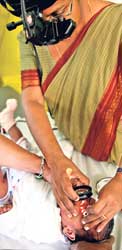
An eye openerThe eye clinic at the Lady Ridgeway Hospital for Children set up last year has filled the acute need for a paediatric eye unit. "Amma diha baba balanawa neda? Den eswala prashnayak ne," says Consultant Eye Surgeon Dr. Dharma Irugalbandara, gently asking a mother whether the baby looks at her and reassuring her that there is no problem with the little one's eyes. The eye examination is over and the squirming baby quietens down as Dr. Irugalbandara applies ointment on both eyes and awaits the next child patient.
MediScene is in the crowded eye clinic of the Lady Ridgeway Hospital for Children in Colombo, started just last year, with major plans to set up a fully-equipped Eye Unit, once the building for which the foundation stone has been laid, comes up in about one year. This year alone 4,423 children have been treated at the LRH eye clinic, while 145 surgeries have also been performed, explains Dr. Irugalbandara, adding that earlier all children (birth to 15 years) had to seek treatment at the Eye Hospital. "The child's eye is not a small version of the adult eye and though children were being seen by General Ophthalmologists, there was an acute need for a Paediatric Eye Unit, with doctors specializing in this area," she says, adding that the eye is a complex organ. Citing an example to prove her point, Dr. Irugalbandara says a cataract operation in an adult and a child would be different. "In an adult, the Eye Surgeon performs a capsulotomy (an incision that opens the clear cellophane like capsule that wraps the eye lens) and puts in the new lens, while if you do the same to a child, as the child grows, the lens tends to be pushed out. So, for children a capsulorexis (tearing the bag circularly) has to be performed." Before the regular eye clinic was started at the LRH, Ophthalmologists from the Eye Hospital used to hold a once-a-week clinic here. But, MediScene understands that it was not catering to the needs of children from all over the country who seek treatment at LRH. Now Dr. Irugalbandara sees patients at the eye clinic at LRH everyday except Monday and Sunday. On Mondays, it is visits for her to check out the eyes of the newborns at the De Soysa Maternity Home and the Castle Street Hospital for Women, while Sunday is her only rest day, unless there is a patient who needs her expertise.
And the clinics are crowded, with about 25-30 children coming in daily to LRH and the numbers swelling to 100-120 on Saturday. Explaining some of the commonly seen problems in Sri Lanka, Dr. Irugalbandara says retinopathy of prematurity is one because in this country the survival of premature babies is high due to the efficient healthcare system we have. "Babies who are born before they are 32 weeks and weigh less than 1,500 kilograms need to be examined by an Ophthalmologist as soon as possible as they are at a higher risk of suffering from retinopathy of prematurity," she says urging paediatricians to call in the Eye Surgeons to check the babies early. There is a belief that the baby needs to be off the ventilator before an Eye Surgeon sees him/her. That's a myth. Call the Eye Surgeon immediately, is her plea. Retinopathy of prematurity needs laser treatment correction, says Dr. Irugalbandara, commending Senior Eye Surgeon Dr. Charith Fonseka for handling these child patients, among his other workload, for a long time at the Eye Hospital. "He used to do the screening, the laser treatment and also the follow-up. Now I do the screening and the follow-up at the LRH while he does the laser treatment at the Eye Hospital," she says lamenting the fact that there is only one laser machine. Urging parents not to allow children to play with dangerous toys such as sharp arrows and bows and pellet guns which could cause blindness, Dr. Irugalbandara's earnest request to paediatricians is that they should not ignore even a minor squint in children. There is a myth that waparaya (being squint) enhances the beauty of a child. Dispelling this myth, Dr. Irugalbandara talks of a child who was detected with a squint at three months. "The parents didn't do anything, neither did the paediatrician," she says, adding that when the child was seen by her at nine months, she spotted a large tumour in the eye. "It's a cancer. If the child was brought at three months we could have done much more than what we may be able to do now," she says. "The child may now lose the eye." Do not delay. If you suspect that something is wrong with your child's eye, show the child to an Ophthalmologist, advises Dr. Irugalbandara.
|
|| Front
Page | News | Editorial | Columns | Sports | Plus | Financial
Times | International | Mirror | TV
Times | Funday
Times | Medi Scene || |
| |
Reproduction of articles permitted when used without any alterations to contents and the source. |
© Copyright
2007 | Wijeya
Newspapers Ltd.Colombo. Sri Lanka. All Rights Reserved. |

